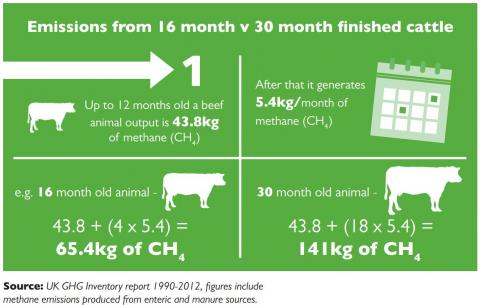The beef industry is coming under increasing pressure from governments and various organisations to reduce the amount of Green House Gases it produces. Recently, in conjunction with the Paris Climate Conference held at the end of 2015, there have been a number of dramatic headlines circulating within the media drawing attention to the contribution of beef production to climate change.
Regardless of your opinion on Climate Change, this issue is something that the Welsh beef sector must deal with, as it is not going to go away. In terms of greenhouse gases, the key ones for the sector are carbon dioxide, methane and nitrous oxide. These are all included in the carbon footprint of Beef, with methane and nitrous oxide converted into carbon dioxide equivalent units in most reports.
Direct carbon dioxide emissions from beef production in Wales is relatively low in comparison to more intensive grain fed beef systems. Being a predominately grass forage based system, the associated losses of Carbon from the soil associated with arable land is not that prominent here. In arable systems, due to regular soil disturbances the stored Carbon within the soil is broken down by soil biota and released as CO2. This change of land use from grasslands or forested land to arable over the past 50 years is believed to be a major source of CO2 emissions into the atmosphere. But due to the long term leys and permanent pastures which dominate the Welsh landscape, soil C levels have remained fairly constant.
Of all the GHG’s, methane is the one that farmers can potentially reduce most effectively and practically. Methane is a by-product of food digestion within the rumen, and it is associated with all ruminants, not just cattle. Compared to CO2, methane is considered to be 25 times worse as a GHG over a 100 year period. This means releasing 1kg of methane into the atmosphere is the same as releasing 25kg of CO2. With this in mind, it is possible to see why methane emissions have such an effect on the C footprint of beef production.
What can farmers do?
There are a number of things farmers can do to reduce the amount of methane produced for every kg of beef produced. One of the main drivers is days to slaughter; an animal that is finished at 16 months compared to one at 30 months will have emitted substantially less methane during its lifetime. Therefore optimising animal performance is key. Genetics, animal health and nutrition all play a key role when it comes to the performance of any animal, and is something Welsh farmers are continuously trying to improve.
Another major gain made within the Welsh beef industry in recent years, is the increase in the amount of beef produced from the dairy herd entering the food chain. In the past, the majority of male dairy calves would have been culled, but now more and more are reared and finished. Given that for every 100 cows ~83 calves are produced, for every 83 beef calves finished from the dairy herd 100 less adult suckler cows are needed. This offers the industry a huge saving in terms of GHG emissions.
As for Nitrous oxide, many farmers are already adopting dribble bars or trailing shoes as a method of slurry application, which reduce N losses into the atmosphere compared to splash plate. With the use of inorganic N fertiliser a significant source of NO2 loses from soils, correct timing and amount of application makes both environmental and economic sense. By maximising plant uptake of N and reducing losses into the atmosphere the farmer gets the best return of investment on purchased inorganic N fertiliser.
Despite the negative press associated with Beef production, Welsh farmers are in a very favourable position to produce beef of the highest ethical standard with a low carbon footprint in the future; as a result of improved efficiency’s within the industry and the production of human edible mega joules from land not suitable to grow most food crops.

